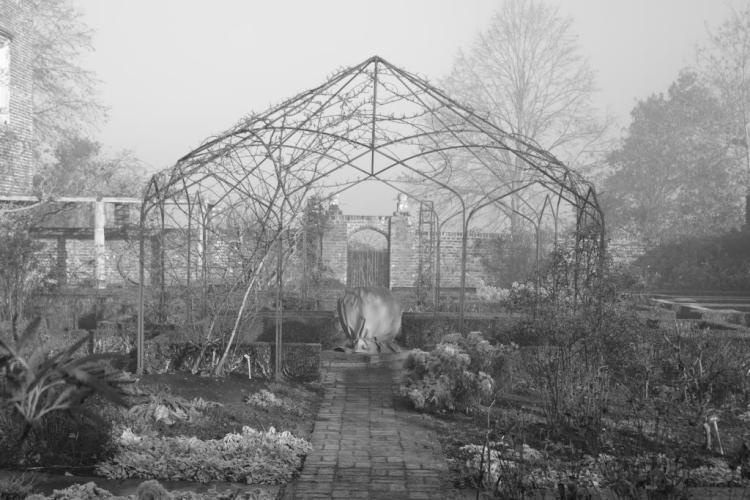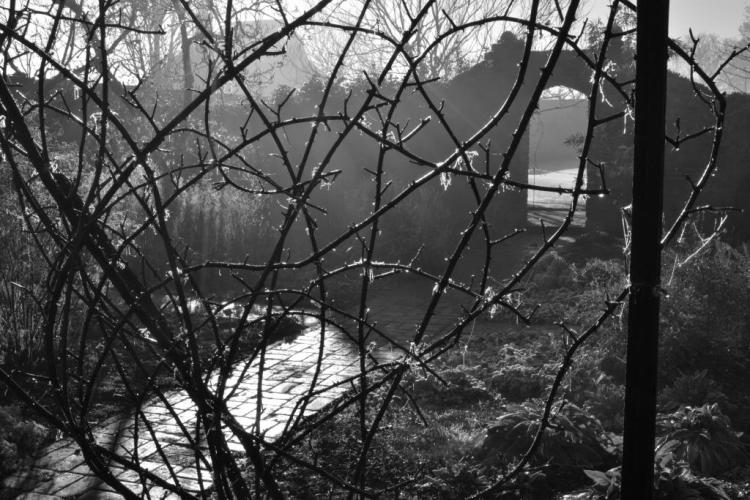Having recently finished pruning the famous white garden rose, R. mulliganii, aided by the skilful help of gardener Claire , I have decided to delve into the story of how this rose, the central character in the White Garden, came to shine so brightly in the limelight.
Originally, right at the beginning of the 1930’s the White garden began life as a Pink and White themed rose garden, inspired by Persian design and one of the first areas of the garden to be laid out. Almond trees were planted to form an avenue, through which, Rosa Filipes, Sir Frederick Stern’s, Garland and Wedding day were woven.
The Chinese ming vase appeared in later in 1937, bought by Harold from Egypt to create a centre piece and establish the main focal point in this evolving garden space.
There is a question mark somewhere, around this time about another rose mentioned in various books called R. longicuspis. This chinese species similar in many ways to the present day R. mulliganii, must also have grown up the almonds, but I found no exact date of when it was planted.
The concept of an actual white garden, or Vita’s ‘Grey garden’ (Observer, Jan 12, 1950) was not properly conceived until 1939. This is when Vita imagines a garden full of white, silver and green plants. During this time she seeks advice about planting from Graham Stuart Thomas and employs Jack Vass as Head gardener. From now onwards, her silvery vision begins to take shape, that is until war is announced and progress in the garden is frugally rationed and becomes somewhat neglected.
At this point, I have chosen to travel forward through time and many historical events at Sissinghurst to arrive at 1970.
This is when Nigel Nicolson, with help from Graham Stuart Thomas is forced to engineer a solution to support the white roses, whose weight and vigour have since damaged all of the Almonds, including the four that remained in each corner of the area where the Ming vase sits. His solution was paper clips. Stretched out to form a miniature template for a metal arbour, inspired by the Elizabethan architecture and later constructed by a local blacksmith to form the metal framework we see today.
Another question is raised at this point. Is this when the now famous Rosa mulliganii was planted? I presume it must have been…
Again I skip a decade or two and must inform you of sad, but not sorry news. Poor Mulliganii has actually been suffering in recent years. Possibly due to hot summers, drought, cold winters, or just fatigue and age. Despite horticultural efforts to reverse this, no vast improvement appeared, so a few years ago another identical rose was planted in the adjacent corner to bolster up the decreasing abundance of the existing rose and provide new shoots to replace old. Additional roses may yet join them. We will have to assess the situation still.
At last, I arrive at the present day and to the annual pruning of this rose, essential to promoting good flowering and retain the trained in structure.
Claire and I were given the task this year and work began in mid-November. A suitable time to start your winter rose pruning.
Normally, this vigorous rose is so thick with growth that you can barely see the sky. No longer is this the case.
We begin by shortening flowered growth, produced along the older shoots, which were tied in to create the main framework over previous years. Then, we repositioned existing growth and tied in precious new shoots, to provide fresh flowers for next June. The newly planted rose did provide a few long, healthy shoots, so these were trained in to fill any gaps.
As you will see from the photos, we train these shoots to create curved arches, spread across the metal arbour. The flexibility of this rose and our fingers allows this to happen very well and produces a beautiful spectacle, described by some as ‘Living Lace.’
So what does the future hold for Rosa mulliganii? Will she be axed? Or will her new companion spur her on? Maybe the early blossom of almonds trees could join her and relive her youth.
By Jo







Are cuttings of this rose being taken?
LikeLike
Loved the article. Helpful advice and nice photos
LikeLike
Pingback: Travel in France, Apremont-sur-Allier, Parc Floral | London Life with Bradshaw's Hand Book